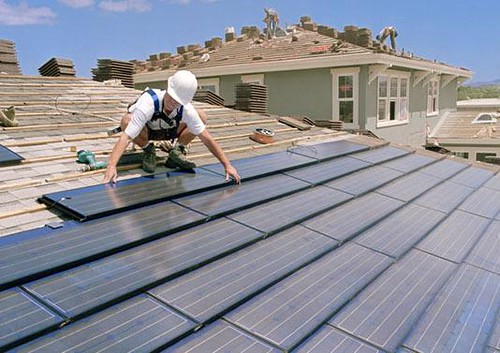Solar Roofs
Posted by Big Gav in solar pv, solar roof
Technology Review has a look at progress in the world of prefabricated solar rooftop panels (often referred to as BIPV) - Solar Roofing Materials.
In an effort to promote the adoption of solar technology, United Solar Ovonic of Auburn Hills, MI, has teamed with a major roofing company to create a metal roof system that generates electricity from sunlight. The partnership offers seven different prefabricated systems, ranging in capacity from 3 to 120 kilowatts. Tests show that the solar roof panels are rugged and can withstand winds in excess of 160 miles per hour.
In addition to being more aesthetically pleasing than bulky rooftop-mounted panels, solar roofing materials can cut the cost of household solar installations by doing double duty, generating electricity while protecting buildings from the elements. "Ultimately, if you can use one product to do two things, you can save a lot of money," says Cecile Warner, principal engineer at the National Renewable Energy Laboratory's National Center for Photovoltaics, in Golden, CO.
Building-integrated photovoltaics (BIPV) have been around since the late 1980s, Warner says, but only lately have they begun to see some success with large commercial and residential developments. Recent advances in flexible thin-film photovoltaic materials--such as those sold by United Solar--are allowing manufacturers to more easily integrate photovoltaics directly into the roofs and facades of buildings.
Nonetheless, many builders remain leery of the new technologies. "In the past, people in the construction industry have been burned by trying out new products," Warner says. In particular, she says, they're wary of products that would be difficult to recall should they prove defective. Roofing materials certainly meet that description. "I think that's probably been the sticking point all along," Warner says. ...
When solar companies partner with construction firms, "it gives the product a lot more credibility, and it helps to break down the barrier to adoption," says Warner.
Centria designs and assembles the solar roof systems using United Solar's adhesive thin films, which can simply be peeled off of their backings and stuck to the roofing materials. The company then distributes the final product through small metal-roofing manufacturers that do the installations for building owners and architects. EnergyPeak comes with a 20-year warranty and, depending on the state in which the solar roof is installed, could pay for itself in less than 10 years, Centria says.






